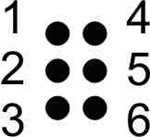I've borrowed the book Just Enough To Know Better ( a braille primer) by Eileen P. Curran, from a center in my area that specializes in working with blind children. I'm making a commitment to learn to read braille, even if it's just the basics, over the time period of 6 weeks. I'm very interested in getting to know how blind people deal with everyday things we all do such as brushing our teeth and combing our hair. Blind children especially hold my interest because they have to struggle to learn how to do ordinary things that most sighted people do everyday. Blind children, unlike blind adults who have been blind for a number of years, are not use to finding a way to handle their everyday business such as adults who have adapted to being blind.
I think it would be great if people who have never thought of learning to read braille could attempt to learn. Learning braille wont stop blindness but it sure will show the blind that someone cares enough to see the world as they do, even if it's only through your hands.
So far i have been working on memorizing the 26 letters of the alphabet. Just like in our early school years when we had to practice writing and memorizing the alphabet, you have to memorize what each braille letter looks like. Every letter, sign, or punctuation mark is represented by a braille cell, which is a unit of six dots . I've made flashcards with each letter on a card to help me memorize them. I am going to be practicing to memorize the formation on each letter and its feel. In a few days when I feel ready I will try to read whole sentences. It's a little challenging so wish me luck!
Example of the braille alphabet
Example of a braille cell


No comments:
Post a Comment